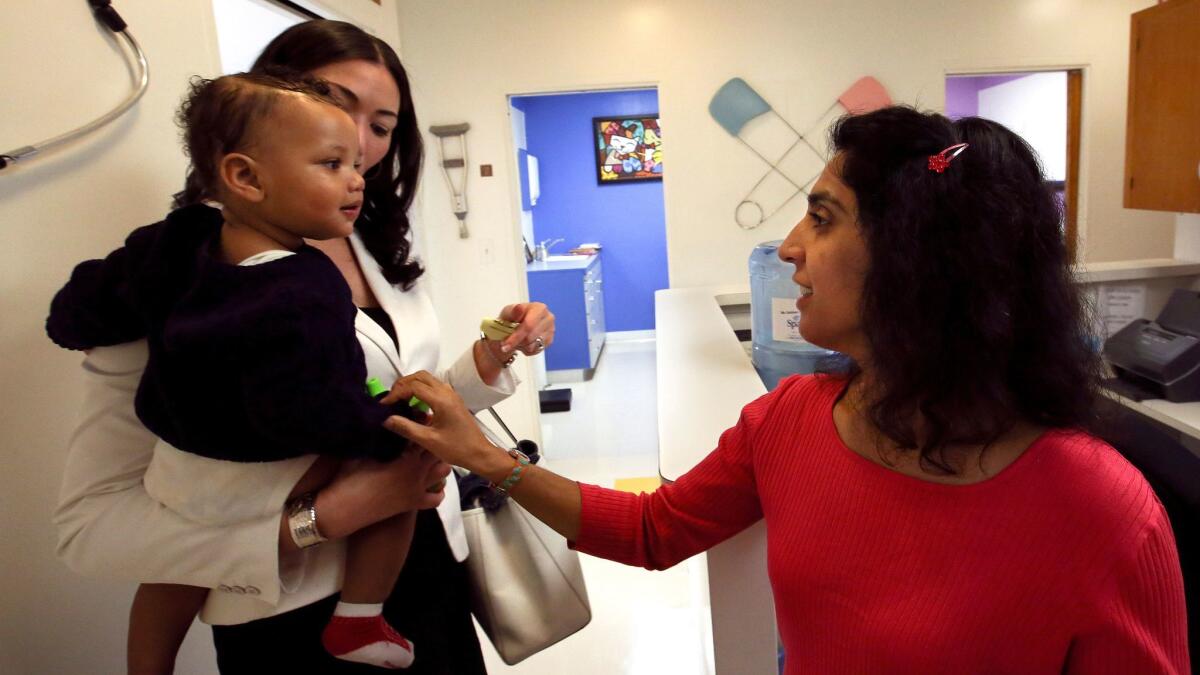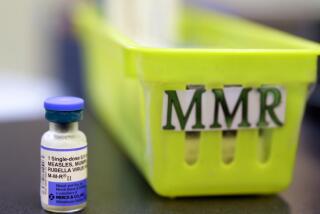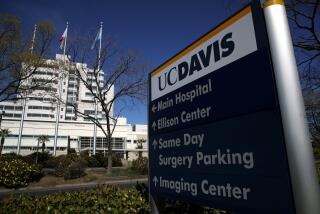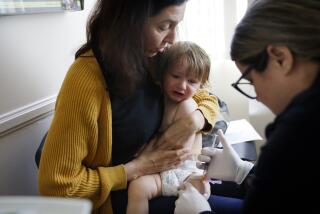Vaccination rate jumps in California after tougher inoculation law

- Share via
The vaccination rate for California’s kindergartners soared this fall from the previous year, fueled by a state law that made it significantly tougher for parents to exempt schoolchildren from shots.
It was the highest vaccination rate among kindergartners since at least 1998, and comes after a measles outbreak that began at Disneyland in 2014 focused new attention on the issue.
New data released Wednesday showed that the percentage of California’s kindergartners as of last fall with all required vaccinations rose from 92.8% to 95.6%. Los Angeles County’s rate jumped from 90% to 95%, and Orange County’s from 92.5% to 95.5%.
More kindergartners were also getting the measles vaccination. An astonishing 97.3% of California’s kindergartners reported receiving both measles shots, up from 94.5% a year ago and 92.6% reported in the fall of 2014, just before the Disneyland measles outbreak struck.
Vaccination rates for whooping cough, also known as pertussis, posted similar numbers.
Experts say the conditions for measles outbreaks are enhanced if the vaccination rate is less than 95%.
Lawmakers who authored the vaccination law, known as SB 277, cheered the results.
“It is gratifying to see that in the course of just one school year, more children — and the public at large — are now more fully protected from preventable diseases,” state Sen. Ben Allen (D-Santa Monica) said in a statement.
“Great news,” tweeted state Sen. Richard Pan (D-Sacramento), who is also a pediatrician.
Pan said in an interview Wednesday that he was encouraged by this year’s vaccination rates, especially because they are higher than the minimum needed to keep a single measles case from spreading rapidly in California.
“Measles certainly hasn’t gone away,” he said, pointing to outbreaks in Europe and one in L.A. County earlier this year. “We need to be sure to have our immunization levels high enough. The fact that this class and the state overall has now achieved this level is one further step to restore the community immunity we had before.”
But Pan noted that the law only affects very young children — and there is still a percentage of schoolchildren who are not vaccinated because of the previously lax law. “This is one year, one step. We halted the bleeding,” he said.
The law requires that kids entering kindergarten and 7th grade have all their vaccinations, so elementary school children already older than kindergarten age will be required to be immunized eventually. But there are thousands of Californians who’ve already crossed 7th grade or graduated from high school without ever having received a vaccine.
The UC system has said it will require vaccines for all new enrollees, but most young adults won’t encounter another vaccination checkpoint once they leave high school.
“That’s why it’s going to take years to restore community immunity,” Pan said. “So I’m really happy about this year, but this is not a declaration that we’re done and it’s over with. This shows progress.”
He said more than the statewide averages, he’s worried about counties with low vaccination rates.
Eight of the state’s 58 counties had vaccination rates below 90%, according to the new data. Viruses circulate in neighborhoods and communities, so regions with low vaccination rates are at risk, Pan said. “We need to shrink those pockets.”
State data also show that the percentage of kindergartners receiving a permanent medical exemption from vaccines has risen from 0.2% to 0.5%. Pan said he suspects the increase is primarily because kids who had always qualified for medical exemptions had been using personal belief exemptions because they were easier to obtain.
He said the state has to monitor whether doctors are providing fraudulent medical exemptions, but he thinks it’s most likely that the increase is due to legitimate medical exemptions.
Kindergartners entering home-based private school or an independent study program that does not provide classroom-based instruction can avoid the state-required vaccinations. The data said that 0.5% of California’s kindergartners were reported as lacking vaccinations under this category.
State health officials said other reasons for the improvement of vaccination rates included audits of schools to ensure they were complying with immunization law. Officials have said that schools often did not follow up on kindergartners admitted on the condition they would eventually receive all their immunizations.
The California vaccine law passed in 2015 was one of the most far-reaching inoculation laws in the nation. It bars parents from using religious or personal beliefs as a reason to excuse their children from enrolling in kindergarten without receiving all state-required immunizations. California joined just two other states — Mississippi and West Virginia — in making such a requirement as a condition for school enrollment.
The law drew hundreds of protesters to the state Capitol, where they argued that parents should have the right to make decisions about their children’s health without interfering with their ability to attend a public or private school.
But most lawmakers and Gov. Jerry Brown said the public health was too important to allow unvaccinated children who don’t have an allergy or other medical excuse to go to school.
“The science is clear that vaccines dramatically protect children against a number of infectious and dangerous diseases,” Brown said at the time.
The decline in vaccinations came amid growing public concern about the safety of vaccines and whether they caused autism, a fear that stemmed from a report in a British scientific journal published in 1998. The article was retracted and declared to be a “deliberate fraud.” Numerous studies have since provided overwhelming evidence that vaccines are safe.
But the damage was done. By 2013, California’s kindergarten measles vaccination rate hit a low of 92.3%. A year later, the measles outbreak struck at Disneyland and grew to become California’s worst since 1991, ultimately infecting more than 150 people and spreading to other states. An analysis published in the journal JAMA Pediatrics said the disease spread thanks to parents who declined to vaccinate their children.
In 2010, an epidemic of whooping cough led to the deaths of 10 infants.
Opponents of the law filed a lawsuit last summer claiming the law violated California children’s right to an education under the state’s Constitution. A judge denied their request for an injunction that would have blocked the law’s roll-out, and the plaintiffs later withdrew their case. They also failed to gather enough signatures last year to put a referendum on the November ballot to overturn the law.
[email protected] | @skarlamangla
UPDATES:
4:15 a.m.: This article was updated with a statistic from Los Angeles and Orange counties and context about a 2010 whooping cough outbreak.
9:30 p.m.: This article has been updated with comments on the vaccination numbers and background information.
This article was originally published at 5:05 p.m. on April 12, 2017.
More to Read
Sign up for Essential California
The most important California stories and recommendations in your inbox every morning.
You may occasionally receive promotional content from the Los Angeles Times.












